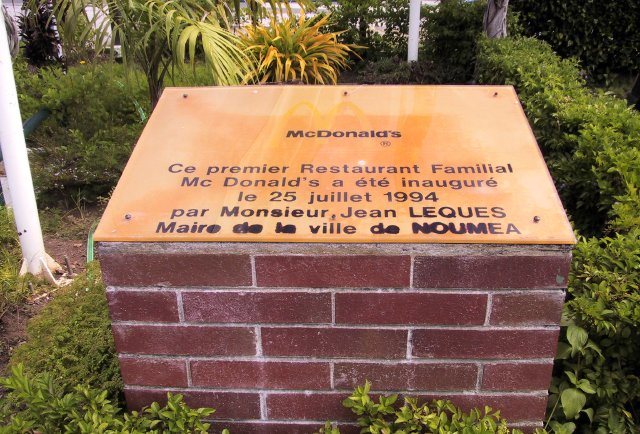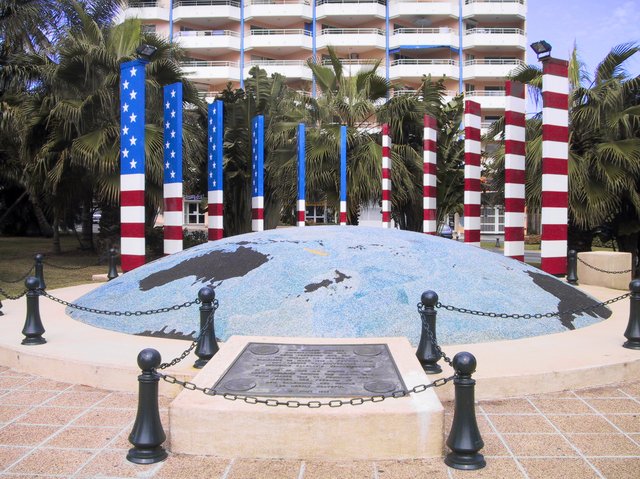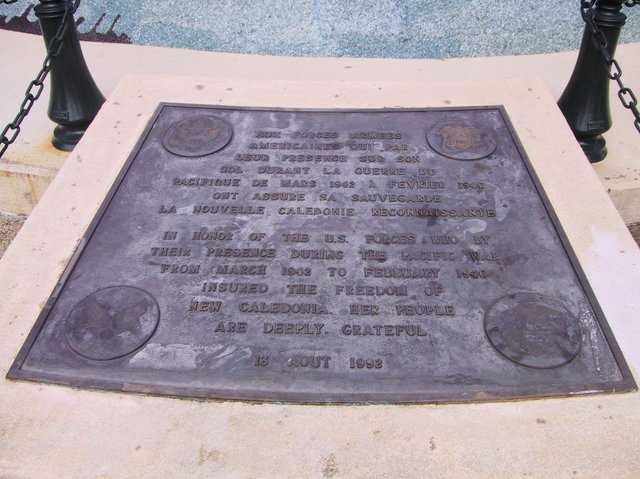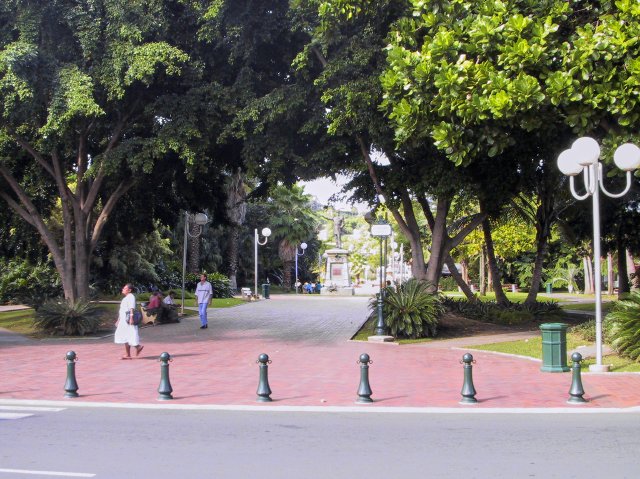Day of wandering about central Nouméa... with actual decisiveness towards the end! We rent a 4WD!
10:00am
One of the frustrating things I'm finding here in New Caledonia is that there are interesting
things to see here on this island, but finding out where they are and how to get to them is
very difficult. I've been trying to find more information about the strange plant life and
landscapes here--but to no avail. The ranger at the Parc Provincal de la Rivière Bleue
didn't have information, the botanic gardens didn't either (we were told to wait until
Tuesday), and there are no real eco-tours here from what I can find. We're probably atypical
tourists--wanting to see the landscape and natural plants isn't something that's on most Japanese
package tour itineraries, which seem to revolve around seeing fish and looking through shops
selling pearl jewelry.
Still--I have found nothing. Tim Flannery, when writing "The Future Eaters", also seems
to have found things difficult, he mentions that 'eventually he found a manual of plants'.
6:00pm
Found an internet cafe. Nice, fast connection, though it did cost 1000XPF per hour for each
of us... and by doing some Google searches found out quite a bit more about New Caledonia
interesting plants. Curiously, the Missouri Botanical Gardens was a good starting point--it's an
area of research interest for them! By looking at a conference paper, many of the araucaria
grow on high mountain tops, with quite a few also growing in ultramafic soils. Almost all are
limited in distribution, and there are 13 species, all endemic. The biggest chunk of
ultramafic soils--the 'red soil' is found in the grand south of New Caledonia, to the east
and south of Nouméa.
Chris also found a group at Oxford University that's very interested in Araucaria... and they held a conference in Auckland this March with a special tour to see them here in New Caledonia. Drat! We missed it. I'm starting to think that the only way to really see all these is to join an expedition.
Afterwards, we found a bookshop where I picked up the book Tim Flannery referenced called
Fleurs et plantes de Novelle-Calédonie by Maurice Schmid. Though printed in 1981, twenty
years ago, it's not totally out of date.
Across from the bookshop was the main tourist office, and I found information on 4WD
tours of the south--and a pamphlet on the Chute de la Madeleine, a provincial botanic
reserve! This was a cool find, as it has pictures of several of the odd plants, and a
trail map with their locations marked on them. Though unfortunately... it requires a
4WD to visit the reserve. We called and left a message with one of the tour group companies
that had good English on its photocopied A4 paper.
Armed with this... we called and left a message for the tour company, then checked out prices for 4WD car hire by walking by the agencies. We found one that rented a Land Rover Freelander for 6900XPF a day including 150km free, then 40XPF per kilometer excess. After discussing this: 'should we wait for the tour to come through?' We said 'nah, we'll just do it ourselves.' The car rental guy was funny: he said 'oh, you can return it at 3 tomorrow, give or take a Pacific hour. Nothing here is really precise.'
We drove back to the hotel... Chris booked a lunch at a gîte on the south coast with typical Kanak food... yam, taro, and sweet potato is what we're expecting. And we'll just drive east at daybreak, and head out to the hills!
6:20pm. Expensive.
Chris says this is probably the most expensive place he's visited. I am really starting
to agree. For example, the hour of internet cost us 1000XPF each, for a grand total
of 2000XPF. That's about half the price of a cheap daily car rental (at 2350XPF including
150km free. About the only thing we found that was cheap was the roadside bananas... they
were 200XPF for a bit more than a kilo... though we couldn't tell for sure, as there wasn't
a scale, just an honesty box. We did get maybe 15 small baby bananas off the banana hand.
10:00pm. Our Dinner with Andre
A very good dinner down at the bayside restaurant where international yachts and sailboats dock...
drinks beforehand at Andre's house, too! Very pleasant conversation. There were a few tidbits
that amused and interested us:
- The local Kanak people consider flying fox a delicacy. Imagine all the tasty treats they could
have from the thousands of flying foxes at the Sydney and Melbourne Botanic Gardens!
- Andre says Mt Humboldt is a great place to go hiking, but it's at least a day and a night's
worth of hiking
- Nouméa was the major US headquarters for the South Pacific in World War II, and the feelings
of goodwill, friendship, and gratitude towards America is strong even today, 60 years later. There
are even two Nouméa neighborhoods that retain their names from these days: one suburb is called
Motor Pool, and right next to Motor Pool is Receiving!
Other Notes from Today
- Get Trim's biography, written by Matthew Flinders
From Internet searches, generally Google on "new caledonia flora" and "new caledonia
araucaria". http://www.mobot.org was referenced often.
- Araucaria nemorosa only is found at Port Boisé [extreme south end of the island], and only
twelve plants are known to exist
- Araucaria muelleri can be found on Haute Ouinné
- Araucaria rulei can be found at Prokoméo
- Araucaria scopulorum can be found on Montagne de Poum
- Araucaria humboltii can be found on Mt Humboldt
- Many araucaria species in New Caledonia occur in the maquis, and are quite short (<2 to 3m tall)
- The pink flower growing on the tree trunk that I took a picture of a few days ago
is likely a Geissois species (Cononiacea family). One place it occurs is Mé Ori
- Another plant I took a picture of is Xanthostemon auranticacum, with red 'petals' and light
green leaves
- New Caledonia soils are highest in iron and magnesium, with high concentrations of nickel,
chromium, cobalt, and manganese, and low in nitrogen, phosphorus, potassium, calcium, and aluminum
- From a paper presented at a 1996 conference on endangered plants, I found this table
interesting... especially considering that New Caledonia's about the size of Hawaii,
and 1/14th the size of New Zealand... Endemism is 'how many species are considered only
found in the given province or area?'
| Place | Species | Endemism |
|---|---|---|
| Hawaii | 980 | 89.2% |
| New Zealand | 2066 | 81.9% |
| Madagascar | ~10,000 | ~80% |
| New Caledonia | 3250 | 76.4% |
| Cape region, South Africa | 8493 | 68% |
| Juan Fernandez Islands (500km west of Chile) | 168 | 67.9% |
| Fiji | 1302 | 61.4% |
From the Museum of New Caledonia:
- The 'sago palm cycad' that grows in NC is of the metroxylon species
[this is older signage and may be false]



